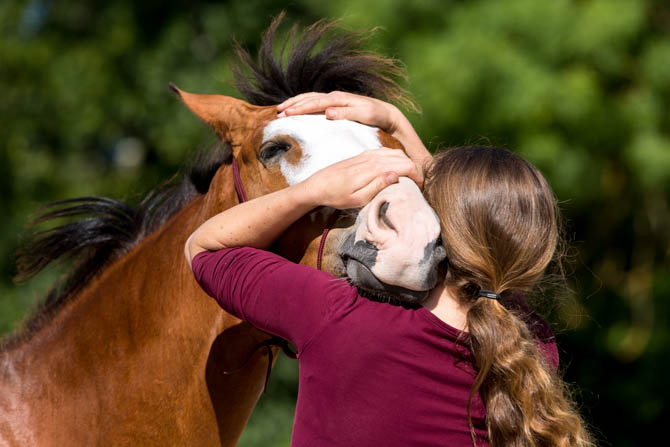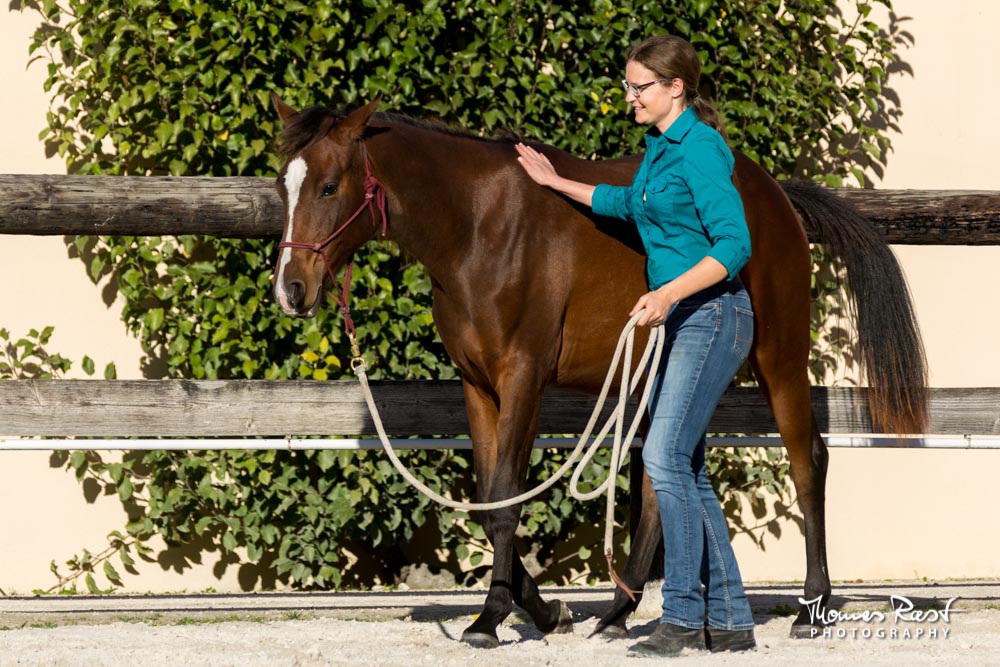Young Horse Education - 4 innate ways of learning
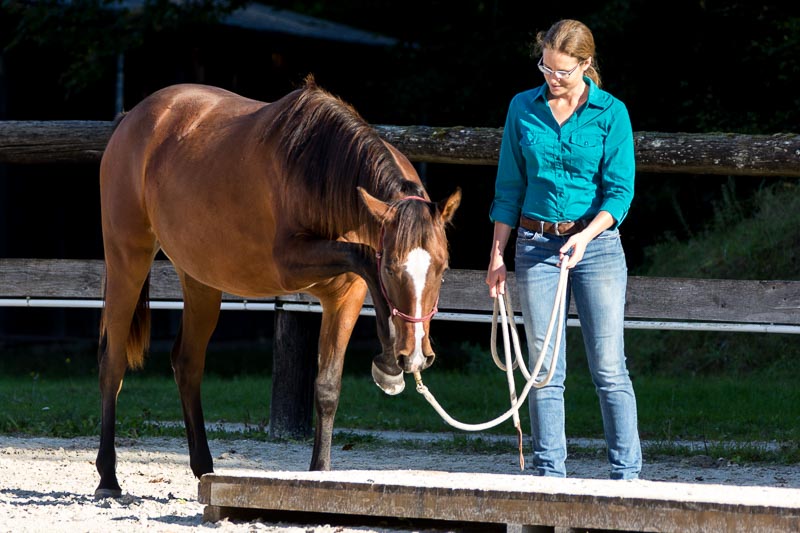
Many horse owners have this dream of owning their horse from foal age on and of growing together. For me, there is nothing better than this. The relationship can grow slowly, without the pressure of performance, lots of time is just spent being together and (hopefully) enjoying each other.
I had this experience with Mayana and I am having it right now again with Tara and Maserati. I really love every moment of it and appreciate it with full awareness—a lot of joy comes with it.
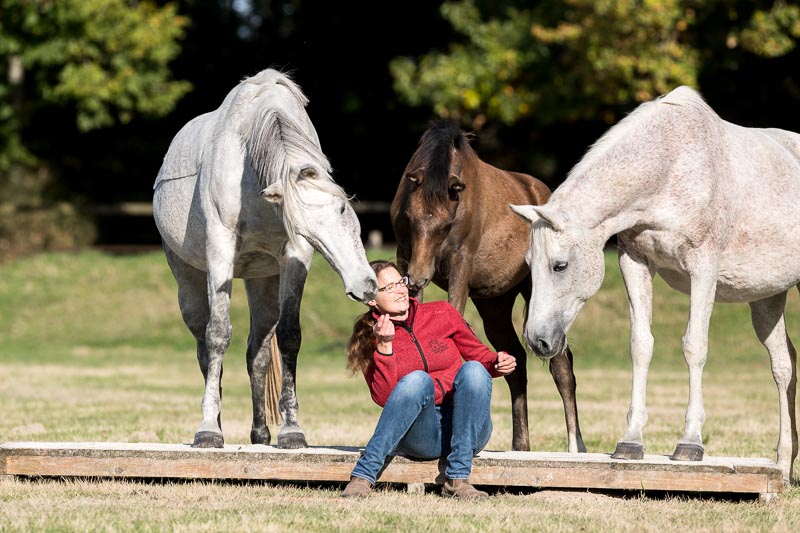
My horse family and me. Mazirah, on the right, with her two “kids”, Maserati (middle) and Mayana. Nothing is better.
But, and I am sure that I am not the only young horse owner who is experiencing this, I wish to do everything right.
I hope to make no mistakes. Provide perfect conditions and learning opportunities for the foal, pay attention that he doesn’t learn stupid things or makes bad experiences. This can be haunting, makes us doubt ourselves, makes us insecure and guess what—our youngster will notice.
So what is important with the little cuties? How do they learn? What do they have to learn?
First of all—RELAX!
There is time, plenty of it, but use it.
They are just kids, so they learn constantly. Even without that we actually teach specific tasks, they learn:
- by their curiosity
- by making experiences
- by making associations and
- by imitation of each other and older horses
In short: they learn “by the way.” What does this mean for us?
1. The importance of curiosity:
Being curious is something very normal to all young animals and also to humans. Without curiosity, there is no learning, no interest, no participation, just boredom and fear.
« Never knock curiosity out of a young horse » — Tom Dorrance
This is one of the most important sentences when dealing with foals and youngsters. Their innate curiosity drives them to explore and investigate things. I understand that it can become pretty annoying once they start to empty the grooming box or toss over the wheelbarrow of just collected poop.
We tend to tell them off so quickly in moments like this. Instead, we should nurture and direct this curiosity, then we can use it to our advantage instead of being annoyed by it. Curiosity develops after fear and flight and opens the door to confidence.
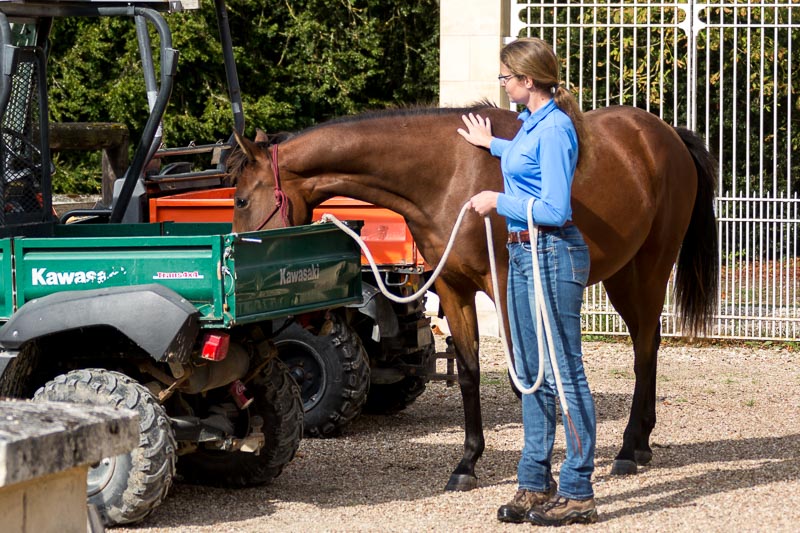
By allowing them to be curious, young horses learn very naturally. My 18-month-old Tara is exploring one of our farm vehicles.
The natural chain of reaction of a horse is like this: He gets spooked by something, then turns around to have a look and he will get curious about it. He will go and investigate and eventually become confident because he realizes that the object wasn’t dangerous after all.
The beauty of it: we don’t have to do anything to help the process, except to provide the stimulus/object. Provided that the horse didn’t already make a bad experience with this object or stimulus. This will be a whole different story.
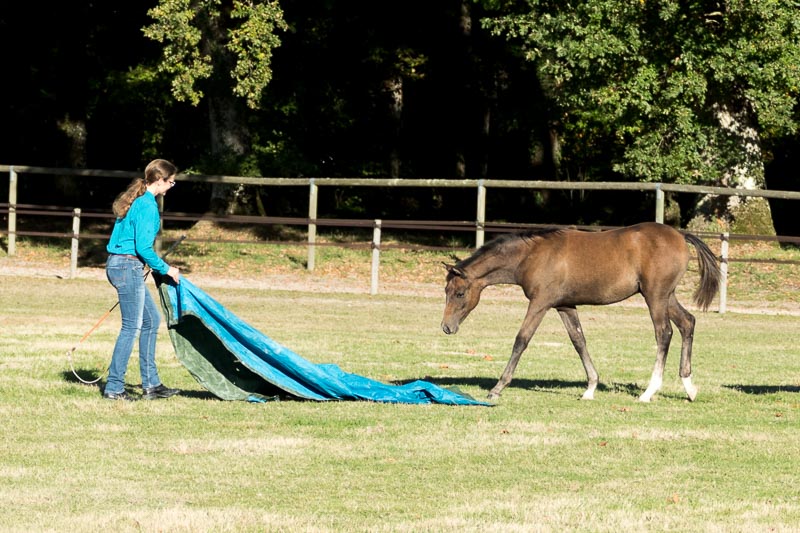
Maserati is meeting a plastic tarp for the first time. His curiosity drives him to explore it closer.
For example, you can bring a big plastic tarp into your youngster's field and let him deal with it. You can take him with you when you go with another horse into the arena to ride. Plant all kinds of stuff all around the arena and just allow him to explore on his own terms.
Often foals and youngsters will also just walk into a horse trailer by themselves out of curiosity and if we give them enough time. Usually, it is us who create the drama by expecting a drama reaction from our horse and by pushing them to get it done faster.
Setting it up in a safe way and then let their innate curiosity work for us, allows the youngster to learn in a very natural and easy way. The more they see and explore at a young age, the less spooky they will be later on. They will be more open to deal with unknown things and situations.
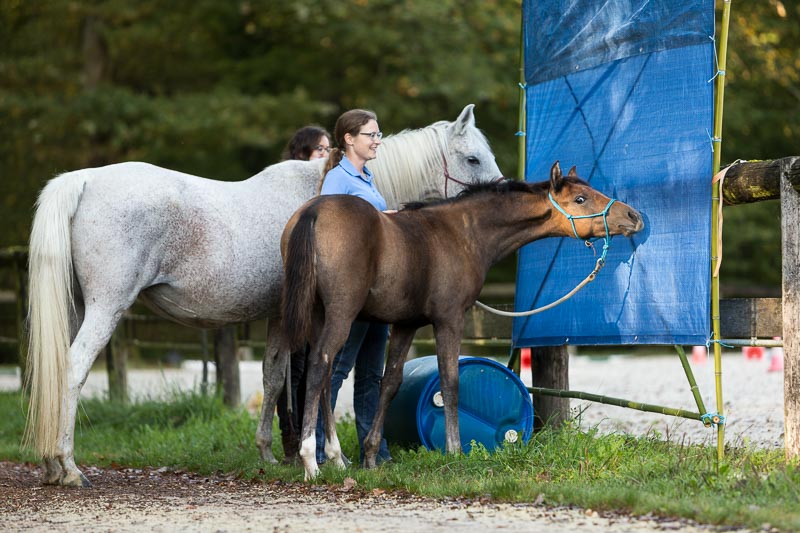
Maserati`s curiosity is stronger than the scepsis he had at first about the big blue thing.
So, allow your little one to be curious, to explore the world and show him/her lots of stuff. The cherry on the cake—they learn that whatever we show them and confront them with is OK.
2. Learning by Making Experiences
Making experiences comes right along with life, with daily interaction and with curiosity. Some experiences we can’t prevent and I think we shouldn’t—like, for example: touching the electric fence. There are good and bad experiences and both are necessary to make.
Often times we try to keep “bad” experiences away from our horses. They have to make all of them, of course, within a safe frame. This will enable them to make their own decisions later on.
For example, my mom told me to not touch the hot ironing clad because I would burn my hands. Guess what I did the next second she didn’t pay attention? I put my flat hand on it—I had to burn my fingers so I could believe.
It was not a nice experience, but a very educational one. And I did it because I was so terribly curious. It is a natural process of learning, discovering what is possible and what is not. What is nice and what is not so nice.
The Importance of “First” Experiences
We can, and I think we should, influence the experiences our youngsters make—particularly the “first-moment” ones. The first vet, the first trim, the first time crossing water, the first time going for a walk…
With a little bit of awareness we can prepare and set up for success, so these “first times” are good experiences.
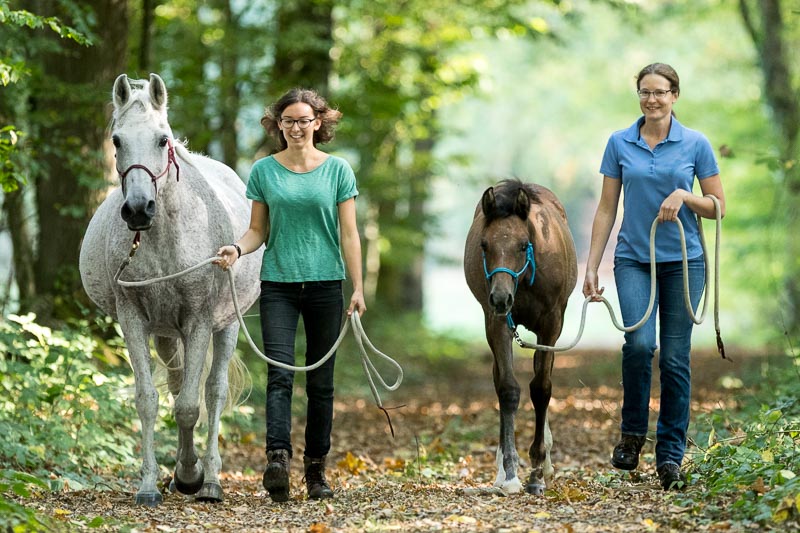
Set up the “first times” for success! Maserati on his first walk in the forest. His mother is giving him confidence.
This doesn’t mean that everything has to be calm and without excitement. What counts is that these first times end on a good note, the young horse feeling happy and confident.
For example, we could ask the vet to just say hello, give a good scratch and simply take five extra minutes followed by a carrot. Rather than just quickly getting it done and leave when the horse just had a bad feeling.
The first walk out into the forest could be together with a good old buddy who is confident out there. The youngster will have an interesting and positive day instead of maybe a fearful experience.
There could be many reasons for a youngster to worry: away from home and his buddies, in a big dark forest full of scary creatures…..
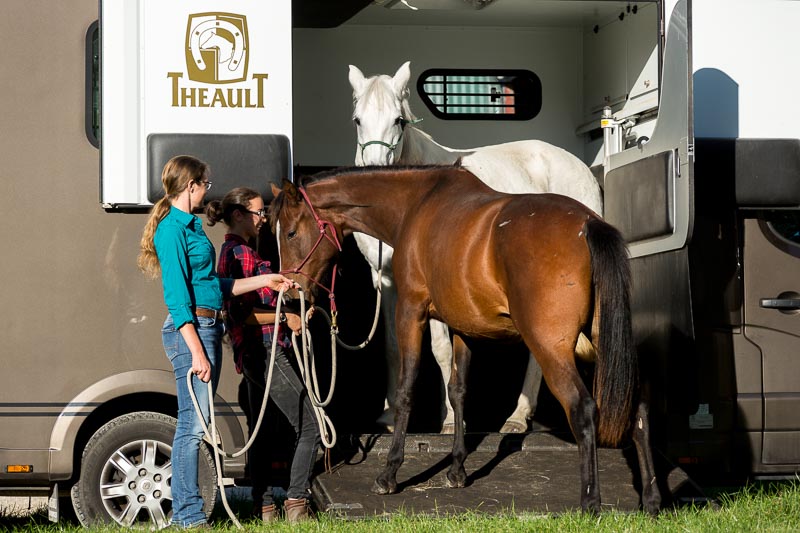
The lead mare Youshka is helping Tara to learn about trailering. This makes it a lot easier for my little girl.
It is important that these first times are positive experiences, as they will lead the horse to think positively about these subjects.
This leads us to the next point:
3. Learning by associations
This means: if an experience is made several times in a row, in the same way, the horse will make an association—positive or negative. He will start to like or dislike, feel good or bad about something.
For example, each time you show up in the field and you spend some nice time scratching and playing around with your little one, he will start to look forward to your visits. He will start to happily look forward to spending time with you!
And the good news is, this association will be very solid if the first encounter was a good one! This is the start of a great relationship that lasts!
This is what we can actively do for our future equine friends—let them build lots of positive associations with awareness. We can have an influence on what they think about everything.

It is not about tasks, it’s about building positive associations and habits.
If each time you take your little friend away from the herd is nice and interesting and you end each session with a success, he will one day become a workaholic. He starts to be happy about going away from his friends and doing interesting things with you.
Creating this attitude just requires a little bit of awareness from our side.
Lots of horses have these associations in their minds:
- Halter = feeling trapped and restricted
- Vet = scary
- Arena = boring or force
- Worm paste = something really awful
- Going away from the herd = feeling insecure and scared
- Human = better run because he will force me to do stuff I don’t like
- Farrier = big scary man with a loud voice who pulls on my legs
- Bridle = device that hurts in the mouth
- Box or stable = feeling trapped and alone
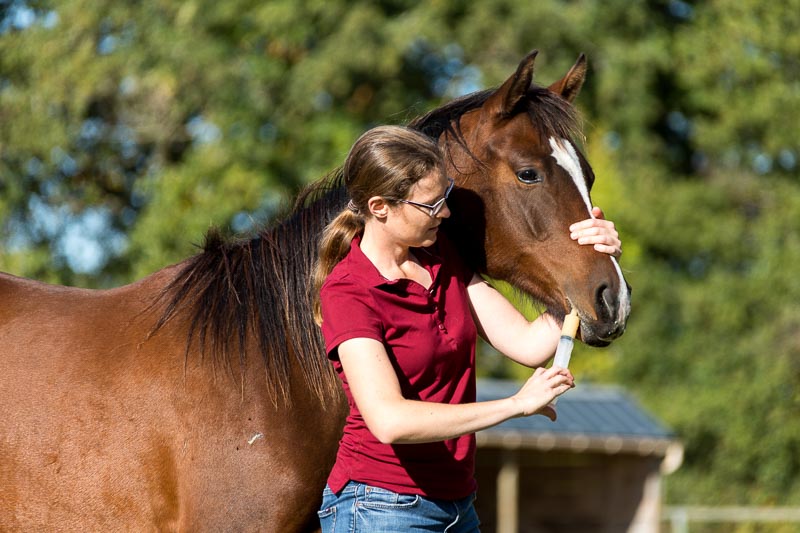
How does your horse react when you come with the worm paste?
Wouldn’t it be nice if our horse would learn this instead:
- Halter = let's do something interesting
- Vet = nice person who scratches and gives a carrot when I hold still.
- Arena = great place to do interesting stuff and my human is always so happy about me in there
- Going away from the herd = being together with my favourite human to do cool things and get lots of praise
- Human = very nice being that brings scratches, entertainment and food
- Worm paste = it might be applesauce?
- Farrier = once a month person who looks at my feet which is OK
- Bridle = tastes nice and makes me feel nicely connected to my human
- Box or stable = comfortable and relaxing place

Quarter Horse mare Princesse learnt to associate the bridle with something positive.
And the list goes on. It is up to us to make sure our horses make the more helpful associations.
4. Learning by imitation:
This is how foals learn from the very beginning: imitating their mothers and later on other herd members. As this is innate behaviour, it is natural to them to simply try to do the same thing someone else is doing.
Every good Horse Trainer knows the benefits of a good old uncle horse on a green youngster. I believe that we are using this very simple innate behaviour way too little.
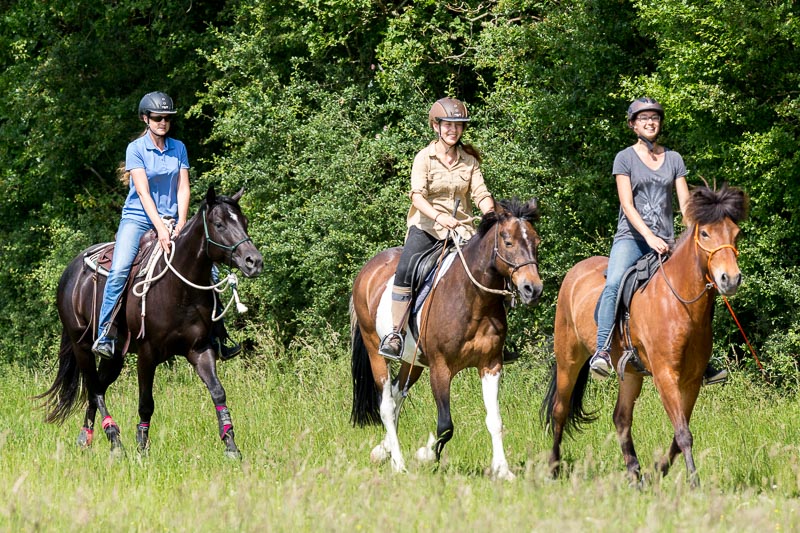
Quarter Horse mare Dancing on her very first trail ride. Two quiet and older gelding accompany her and show how it is done.
The foal will do what his mother does—meaning the better educated and socialized the mother of the foal is, the easier the foal will be to handle. If the mother’s attitude towards the farrier, the shower, the trailer or the vet is relaxed and cooperative, the foal will imitate this and later have the same attitude.
We could use this principle so much more with our youngsters. Almost everybody has this older gelding or mare, who has done it all, seen it all. We can make learning, and especially new situations, a lot easier and more relaxed for our youngsters, if we take a good uncle horse with us.
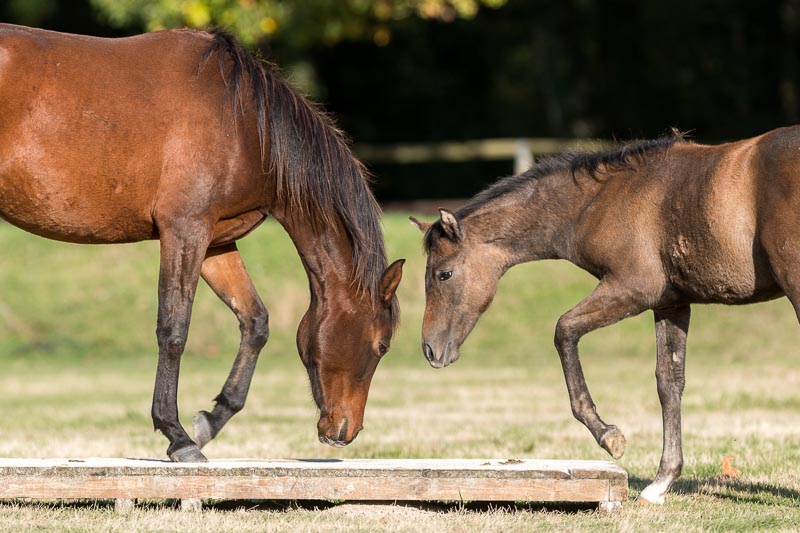
Foals are programmed to imitate what other herd members are doing.
For example, the first time travelling can be set up for success if we travel the youngster not alone or with another youngster but with an experienced and calm horse.
Our youngster will take on the behaviour and energy of his experienced travel mate and learn that this is not a big deal.
The same is true for the first trail rides, showing scary things, or jumping for the first time.
Now, we have to choose our good uncle horse wisely. It has to be a truly cool horse, not just one you can control and produce the physical action! Horses will not only imitate physical behaviours but even before that, pick up on the emotional state of the older, more experienced horse and show this same emotion as well.
Conclusion
Of course, there is much more to say about young horse learning, but I believe they are some very important fundamentals to keep in mind. These 4 principles are like the foundation of all equine learning and behaviour. Keeping these principles in mind will help a great deal to create a happy, confident and curious young horse that loves to be with people and is able to deal with the human world.
Read more Horse Education Articles
